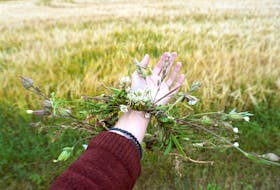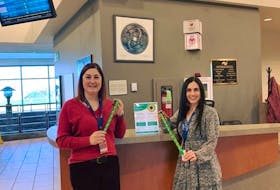ST. ANTHONY, N.L.
NEWFOUNDLAND AND LABRADOR
CANADA
Tourists often comment on how nice and clean St. Anthony is. It is a tribute to the town and its residents, rightfully earned.
I like to get off the beaten path, though, and find my bliss in more secluded wilderness. It took me a few days, but with a little bushwhacking and a good pair of rubber boots, on Sunday, Aug. 19, I found a seemingly pristine stretch of coastline to wander just west of the St. Anthony Bight Loop.
It did not take more than a few steps, however, before I discovered even the unbeaten path is taking a pretty hard beating.
On Monday, Aug. 20 I went back, this time armed with some extra-large garbage bags and a couple of pairs of gloves (work gloves over latex) and, from just 300 metres of beach, hauled out of there two bags of the detritus of our coarser nature: litter.
I found beer cans, coffee cups, water bottles, toys, bait pails, a milk crate, shotgun shells, a deodorant stick, tampon applicators, nets, ropes, tarps, oil containers, dish soap bottles, food wrappers, plastic bags, straws and sundry other items of trash.
That wasn’t even all of it; that was what I could carry out in one trip.
It was, I will understate, discouraging.
I talked to Christopher Mitchelmore, the province’s tourism minister and MHA for St. Barbe-L’Anse aux Meadows, who says he’s also discouraged by the litter.
“Newfoundland and Labrador certainly markets itself as a pristine environment and it’s our natural beauty, our coastlines, those are big reasons why visitors would come here, as well as for our residents to enjoy, so it’s always upsetting to see litter placed in communities and along our coastlines,” he said.
Mitchelmore says there are a number of initiatives in many communities around his district, including St. Anthony, to clean up the mess, but everybody has a responsibility to not let it get to that point in the first place.
“We need to all do our part to keep our nature in pristine condition, and when we are camping or enjoying the outdoors and we are taking waste with us when we go to a place, we should be able to bring that back with us and dispose of it in an appropriate way.”
Mitchelmore adds a lot of what ends up on the coastline is floating in from the sea and boaters should be aware and ensuring waste from their boats doesn’t wind up on the shore or littering the bottom of the sea.
Paul Alcock, owner of Northland Discovery Boat Tours, told me that just last week, the crew on one of his boats rescued a puffin that had become entangled in a shrimp bag. He said that was a first for them, but that he has rescued other wildlife from beer can straps before.
“It’s really sad, but mostly (plastic) bags and other pollution has become an issue,” Alcock says. “Unfortunately, people aren’t being too cautious about what they throw overboard.”
Calvin Blake, waste operations coordinator for the Norpen Regional Services Board, showed me posters, pamphlets and web pages of province-wide education campaigns, media attention and even documentation of fines and prosecutions. Yet litter remains a big problem.
“It’s a very difficult situation,” he says, adding he doesn’t think it’s a lack of awareness.
“People are educated, but people just don’t care, so how do you educate them more? How do you stop them? How do you get them to care? I don’t think there are people around who when they throw a coffee cup out the window that they don’t know that they should not be doing that, but they do it anyway.”
I don’t know what the answer is, either.
We are not our brothers’ keepers, but when it comes to litter, maybe we should be.








